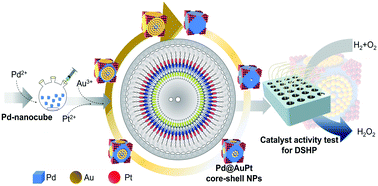Centrifugal microfluidic device for the high-throughput synthesis of Pd@AuPt core–shell nanoparticles to evaluate the performance of hydrogen peroxide generation†
Abstract
We propose a novel high-throughput screening platform using a centrifugal microfluidic device for producing combinatorial tri-metallic catalysts. The centrifugal device was designed to perform 60 reactions under different conditions on a single device. As a model to search for an optimal tri-metallic catalyst, we synthesized a variety of Pd@AuPt nanoparticles (NPs), in which Pd nanocubes served as a core, and Au and Pt atoms formed a shell. The centrifugal microfluidic device was etched on the top and bottom sides, in which two zigzag-shaped microchannels were patterned on the top side, and 60 reaction chambers were fabricated on the bottom side. Through the sophisticated zigzag-shaped microchannels, Pt2+ ion and Pd nanocube solutions were injected into the channel in one shot, and the centrifugal force equally and automatically divided the injected solutions into 60 aliquots during the rotation. By controlling the sophisticated channel dimensions and designing the passive valve structure, the Pt2+ ion, Pd nanocube, and Au3+ solutions were loaded into the reaction chamber in sequential order depending on the programmed rotational direction and speed. Therefore, the ratio of Au to Pt to synthesize Pd@AuPt core–shell NPs was changed from 0.028 : 1 to 12 : 1, and accordingly, the resultant 60 types of Pd@AuPt catalysts presented with different ratios of metal atom compositions. Then, we screened the catalytic activity of the Pd@AuPt NPs for generating H2O2 according to the degree of coating of Au and Pt, and the Pd@AuPt catalyst with the Au/Pt ratio at 0.5 turned out to be the most effective.



 Please wait while we load your content...
Please wait while we load your content...